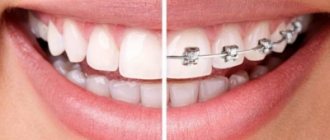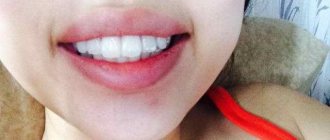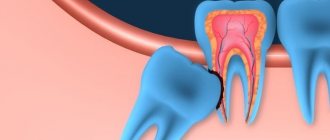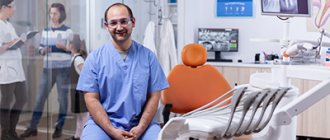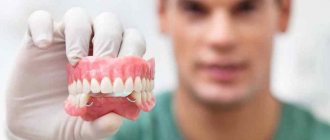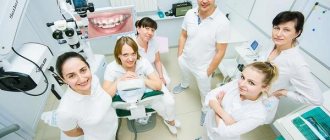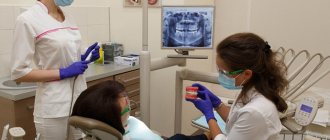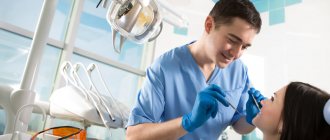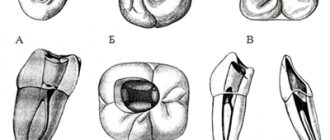Dentistry includes 4 specializations: therapy, surgery, orthodontics, orthopedics. Most dental patients do not understand why they are referred to a podiatrist's office if that doctor specializes in treating and correcting the musculoskeletal system. The article will discuss the question of what an orthopedic dentist does and what issues they turn to him for. We will also consider the types of orthopedic systems called prostheses, bridges and implants.
Scope of activity of an orthodontist
The main task of an orthodontist is the correction of malocclusions6,10, which have an extremely adverse effect on the health of the oral cavity and the body as a whole2,8. It also corrects unevenness of the dentition and individual teeth, dentofacial and maxillofacial anomalies10.
Preventive measures taken by the orthodontist are aimed at preventing the development of the above problems and eliminating risk factors10.
The responsibilities of the orthodontist also include the prevention of complications arising from malocclusion2:
- dysfunction of the temporomandibular joint;
- difficulty breathing;
- changes in diction;
- headaches;
- digestive problems.
Even in the absence of serious defects, many strive to have a Hollywood smile and absolutely straight teeth, so the services of an orthodontist are quite in demand.
Dentist Orthopedist
In dentistry, an orthopedist specializes in restoring damaged teeth and replacing missing teeth. He does this with the help of prosthetics, which is why an orthopedist is also called a prosthetist.
You should contact an orthopedist if you notice:
- Loss of one or more teeth
- Decay of teeth that cannot be filled
- Too loose or sensitive teeth
- Aesthetic dissatisfaction with your teeth - an orthopedist can correct the color, shape and size of teeth
- Pathological conditions of the TMJ
Dentists of other specialties are often referred to an orthopedist; for example, when a tooth is more than half destroyed, therapists say that it is not practical to restore such a large defect with a filling and refer you to an orthopedist to install an inlay or crown.
What treatment methods does the orthodontist use?
There are various methods of orthodontic treatment. The most common of these is hardware3. It involves the use of various designs - removable and non-removable3,11 - with which you can9:
- expand or narrow the dentition;
- speed up or slow down the rate of jawbone growth;
- change the position of individual teeth and the position of the lower jaw.
The devices that the orthodontist works with include:
- Braces are a non-removable system that is fixed on the teeth3,9. It includes the braces themselves, rings, locks and arches3. These elements put pressure on the teeth, moving them in the desired direction3. The method is considered one of the most effective, which is why braces are used to correct most malocclusions4.
- Plates are removable devices with various active elements (screws, springs, hinges). They permanently or intermittently attack the teeth and jawbone3. Plates can be placed at any age, but the best age is considered to be 6-9 years11.
- A pre-orthodontic trainer is a removable elastic aligner that is usually placed at night3. It improves the position of teeth and normalizes breathing, swallowing and muscle tone1.
- Aligners are transparent aligners made of a special thermoplastic material5. They are made after computer 3D modeling of human jaws5, which allows you to see the final result even before they are installed. Aligners should be worn 24 hours a day, removed when eating and brushing teeth, and replaced with new ones every 2 weeks7.
Prosthetic methods
Let's consider all the methods of installing prostheses and implants known to modern orthopedics.
Microprosthetics
The method is indicated when it is inappropriate to install a filling on a crumbled molar: if the tooth walls are severely damaged, but the root is intact. To save the unit from further deterioration, lumineers or veneers are installed. These are dental onlays made of ceramic or other dental material.
In orthopedics, dental inlays and dental onlays are used. An onlay is a plate that is fixed to the tooth enamel of the front part of the crown. Inlays cover the dental canals. They are used to restore chewing lateral molars.
Microprosthetics has no analogues; it is the fastest and most gentle way to restore the integrity of teeth.
How are veneers different from lumineers? To install veneers, grinding is required; lumineers are fixed to the front part of the teeth walls without preliminary grinding of the enamel coating. They are much thinner than veneers. The disadvantages of veneers include the impossibility of installing another type of prosthesis after removal: only the same ones. This is due to the grinding of the enamel layer during installation. Turning is necessary due to the thick layer of veneer plates.
To fix lumineers, turning is not necessary, because the thickness of the plates does not exceed 0.03 mm. But lumineers do not hide all aesthetic imperfections. For example, they do not mask chips in the enamel, unlike veneers.
Removable dentures
Removable dentures are available to everyone due to low prices, and discounts are provided for pensioners. The disadvantage is that turning healthy units is a painful and tedious procedure. Next, the doctor makes a plaster cast and sends it to the laboratory, where a technician models the removable structure.
Removable dentures differ in design features, price, fastening method, and material. These structures provide a solid base to which artificial dental crowns are fixed. In edentulous cases, removable dentures are secured with dental glue. If molars are partially lost, they are fixed to the remaining units in the jaw.
Methods of attaching prostheses:
- staples-clasps;
- locks (attachments);
- pilots;
- telescopic devices.
Clasps are iron brackets that cover the supporting units and securely fix the structure in the oral cavity. They are made in the shape of a semi-arc. The butterfly prosthesis is secured using clasps. This is an orthopedic design whose shape resembles the wings of a butterfly.
Plate dentures are a plate-shaped base to which artificial crowns are attached. This design is easy to put on and take off, and is easy to care for—no need to stick it to the gum.
Removable plates are installed for children who have lost their baby teeth. They help keep your teeth straight.
Clasp prosthetics are used when the patient cannot pay for implantation, and fixed structures cannot be installed. Clasp dentures are an arch on supports on which artificial crowns and acrylic gums are installed. The advantage of this design is the absence of surgical intervention to increase bone mass or the use of a flap technique for restoring the gum edge, as well as an open palate.
However, there are also quite a few disadvantages:
- it takes time for the jaw to adapt to a foreign object;
- daily care of the prosthesis is required;
- the patient cannot remove the prosthesis on his own;
- bone mass continues to decrease due to inadequate chewing load.
Due to subsidence of the bone mass, it is often necessary to replace the old prosthesis with a new one with different parameters.
The best option for the loss of several molars is implantation. Thanks to it, not only the integrity of the dentition is restored, but the patient’s health is also maintained. A full chewing load ensures blood flow to the tissues, and the loss of bone mass stops.
Fixed
Fixed orthopedic structures include bridges and crowns. They are securely fixed in the jaw and can only be removed by a doctor. Single implants are attached to titanium pins implanted into the gums, which replace the tooth root. On top of them are placed artificial imitations of teeth - crowns. If the molar is only partially destroyed, then it is covered with an artificial crown for strengthening and aesthetics.
Metal-ceramic crowns
Crowns are made from various materials - from medical plastic to gold plating. Recently, hypoallergenic crowns made of metal ceramics, which imitate a natural molar, have become widespread. Ceramics reliably protects the mucous membrane from contact with metal alloys, is easy to clean, and does not stain the color of food. Disadvantage: Some metal alloys can cause inflammation in the gum tissue.
Zirconium dioxide crowns
Unlike analogues, zirconium dioxide is not oxidized by saliva. Accordingly, in the absence of oxidative reactions, inflammatory processes in the soft tissues of the gums do not begin. When modeling crowns, computer technology is used, which allows you to create sizes and shapes that are as close to natural as possible. Also, models made of zirconium dioxide have a greater choice of colors: this allows you to choose a tone that will not stand out among the dentition.
Solid ceramic
They are installed on the front part of the dentition; they are completely free of metal components. They cannot be installed on chewing molars: they will not withstand the load.
Implants
Unlike crowns and bridges, they are implanted into bone tissue with subsequent fusion. They look like metal screws and are made from special metal alloys. Implants completely replace lost roots; artificial crowns are attached to them.
Bridges
Installed in case of loss of several adjacent molars. The structure with artificial crowns is attached at the edges to supporting units or implants replacing them. Some designs may consist of five artificial teeth.
Types of bridges:
- metal;
- metal-ceramic;
- plastic;
- metal-plastic.
Metal
They are not used in modern orthopedics, although they used to be widespread. Metal bridges are reliable, durable, and inexpensive. But there is a significant drawback: they are heavy, bulky, and can cause an allergy to metal.
Metal-ceramic
Metal-ceramic bridges are also reliable and durable; they have an advantage over metal ones - ceramic lining. But often the metal base is visible through the ceramics, so such bridges are not installed on the front part.
Plastic bridges
Used as a temporary structure to replace the main installation. For example, they are used while waiting for the manufacture of a metal-ceramic bridge.
Plastic quickly absorbs dyes, so plastic bridges and crowns look unaesthetic.
Metal-plastic
More reliable than plastic ones. However, their service life is short - no more than two years. Then the structure needs to be replaced with a new one. With careful use, metal-plastic can last 5 years, but more often bridges fail much earlier.
According to the manufacturing method, bridges are divided into:
- stamped;
- adhesive;
- solid cast.
An adhesive bridge is used to fix one artificial molar. But it is not reliable because it cannot withstand the chewing load. Stamped products are a monolith of soldered crowns; such blanks are called soldered bridges. These models are already a thing of the past. Stamping has been replaced by more reliable casting methods.
The installation of bridges has a list of contraindications, including:
- bruxism (night teeth grinding);
- abnormal bite;
- periodontal diseases;
- pathological condition of bone tissue;
- lack of regular oral hygiene;
- lack of supporting elements or their poor condition.
Bridges are a good alternative to implants, but they have a significant drawback - preliminary grinding of healthy supporting units. They also do not solve the problem of bone tissue atrophy, which inevitably begins to decrease due to the lack of full chewing load.
When to see an orthodontist
Some people mistakenly believe that bite correction can only be done in childhood or adolescence. But most of these problems can be solved at any age,2 which is why adults with uneven teeth and malocclusions should consult an orthodontist.
Considering that the appearance of malocclusion pathologies can be prevented already in early childhood, it is better to regularly show the child to the orthodontist, even if his teeth seem straight1. When examining children, the orthodontist draws parents' attention to factors that interfere with the correct formation of the bite. The doctor gives recommendations on how to properly monitor the baby’s diet, breathing and sleep. Normalization of these functions has a beneficial effect on the development of the dental system and the entire organism as a whole1.
Orthodontic treatment is carried out comprehensively, combining the work of a dentist-therapist, an orthopedist and surgeon, a speech therapist, an otolaryngologist and other specialists. However, the leading role belongs to the orthodontist. He develops a comprehensive plan for the prevention and treatment of dental anomalies, coordinates the work of other doctors and conducts follow-up2.
The information in this article is for reference only and does not replace professional advice from a doctor. To make a diagnosis and prescribe treatment, consult a qualified specialist.
to come back to the beginning
Bottom line
Orthopedics is a branch of medicine that deals with issues of the musculoskeletal system. Orthopedics in dentistry deals with the problem of restoring chewing and speech functions, returning the patient to the ability to fully chew food and talk with people. If any number of teeth are lost, the patient seeks help from a prosthetist. The choice of dentures depends on the financial capabilities of the patient, the clinical picture, and the equipment of the dental clinic.
The best option is to install implants with subsequent fusion with bone tissue. Such structures protect bone mass from atrophy and completely replace tooth roots. Removable and fixed dentures are cheaper than implants, but do not protect bone and gum tissue from atrophy and loss. The choice of prosthetic method also largely depends on the condition of the patient’s oral cavity: for many, bridges or other structures are contraindicated due to malocclusion, pathology of bone or gum tissue.
Sources used:
- Abolmasov, N. G. Orthopedic dentistry. - Moscow: MEDpress-inform, 2007.
- Lebedenko I. Yu., Kalivradzhiyana E. S. Orthopedic dentistry: textbook. — Moscow: GEOTAR-Media, 2012.
- Wikipedia article
Bibliography
- Bogdan V. E. et al. Prevention of dental anomalies and orthodontic treatment at an early age // Chief Doctor of the South of Russia. - 2013. - No. 6 (37). — P. 4-6
- Kyzina S. L., Rebrova A. E. Orthodontics for everyone // Healthcare of Ugra: experience and innovations. — 2022. — No. 4. — P. 33-38
- Tokarevich I.V. General orthodontics // Educational method. allowance. — Minsk: BSMU. - 2015. - 80 p.
- Khotayt A. Kh., Butvilovsky A. V. Method of manufacturing a non-removable individual retainer // Orthodontics gnathology. — 2022. — November. — No. 2 (3). — P. 22-26
- Kipkaeva L. V., Belkevich V. V. Application of the aligner system in the treatment of dentofacial anomalies in the permanent dentition. Design features. Treatment effectiveness // Orthodontics gnathology. — 2021. — April. — No. 1 (4). — P. 50-55
- Bulgakova A.I. et al. Structure and equipment of dental organizations // Textbook. - Ufa: Publishing house of the Federal State Budgetary Educational Institution of Higher Education BSMU of the Ministry of Health of Russia. - 2016. - 84 p.
- Ganjali N. T. Braces or aligners? // Bulletin of medical Internet conferences. — 2014. — T. 4. — No. 4. — P. 370
- William R. Proffitt et al. Modern orthodontics // Textbook. — 686 p.
- Demina M.A. Positive and negative aspects of working with orthodontic structures, selection criteria // Bulletin of medical Internet conferences. - 2022. - T. 7. - No. 9. - P. 1440-1442
- Alimirzoev F.A. Modern ideas about complex treatment in orthodontics // Achievements of university science. — 2014
- Shkavro T.K., Pavlova I.A. Orthodontic devices // Textbook. – Irkutsk: IGMU. — 2022. — 32 p.
Orthodontics and orthopedics in dentistry difference
The biggest difference, perhaps, is that in addition to an orthopedic dentist, there is also a general orthopedic surgeon.
Next, the orthodontist sets the teeth in their places, aligns the bite, but does not affect the shape of the teeth themselves.
An orthopedist uses dentures to restore teeth and replace lost teeth, thus restoring chewing function and psychological comfort.
In general, there is quite a big difference between orthopedics and orthodontics in dentistry; specialists deal with completely different treatments and we hope that now you will not confuse them.
Consultation with an orthodontist
Not everyone can correct the position of their teeth - but if you dream of seeing a perfect smile in the mirror and do not want to deal with dental problems in old age, you need to consult an orthodontist.
Please note that an examination and conversation with a doctor does not obligate you to get braces. This is an informative consultation where you will learn about your characteristics, possible risks and the approximate course of treatment for crooked teeth. After this, you can calmly weigh everything and decide whether to start treatment.
If you find it difficult to decide to wear braces for a long time, come to us. A consultation with an orthodontist will give you a complete understanding of your situation: the doctor will tell you in detail which teeth need correction, how long you will need to wear braces, and which designs are right for you. You will also learn about the risks that are likely if you do not work with the bite and leave everything as it is.
Braces hurt the oral cavity, what should I do?
After installing braces, each patient receives wax for locks from the orthodontist. At the very beginning, it is worth applying it to the entire system, because the mucous membrane in the oral cavity is not yet accustomed to contact with foreign objects.
Abrasions and wounds heal very quickly. Their healing can be accelerated by using agents that promote the healing of wounds in the oral cavity.
A little bit of history
The first echoes of methods for correcting the position of teeth were found in the works of Hippocrates, dating back to 400 BC. Many years later, namely in 1728, Pierre Fauchard presented to the world a book called “The Dentist Surgeon,” in which an entire chapter was devoted exclusively to the problems of bite and crooked teeth. It was only in the 1850s that the first scientific works on orthodontics or orthodontia began to appear. Thus, one of the pioneers in this area was Norman Kinzley, known not only as a dentist, but also as a talented artist, writer and sculptor. It was he who first resorted to extraoral traction to treat dental protrusion. By 1880, Dr. Kinzley had published a book entitled A Treatise on Dental Anomalies.
The photo shows the first corrective devices
An important role in the formation and development of orthodontics was played by Dr. Farrar, who at one time published the book “Treatise on Disorders of Teeth and Their Correction.” He developed and presented to the world one of the first non-removable corrective devices, and also proposed to provide a gradual and uniform impact to correct the position of teeth with pauses during the treatment process.
In Russia, specialists in the field of orthodontics began to appear relatively recently, namely towards the end of the 20th century. And if in Soviet times an orthodontist was a doctor who treated anomalies of the jaw apparatus strictly according to indications, then after the collapse of the USSR orthodontic treatment increasingly began to be used for aesthetic purposes. To become an orthodontist, it is not enough to study at the dental faculty of a medical university. The young specialist must also successfully complete a residency in orthodontics, but we’ll talk more about this a little later. In the meantime, let's take a closer look at the question: “Dentist-orthodontist - who is he, what kind of doctor is he and what exactly does he do?”
Required qualities
We figured out what an orthodontist treats and how to become one, but in this profession, in addition to professional skills and knowledge, human qualities and certain character traits are also important. The course of orthodontic treatment usually takes from one to several years, during which the doctor will have to regularly meet with the patient, and this will require building a trusting relationship with the person.
Trusting relationships and professionalism are the key to successful treatment
Thus, a good orthodontist should not only be a first-class professional, but also a sociable, efficient and patient person. He must be able to win over the patient, calm him down and set him up for successful treatment, which for him can already result in serious stress, especially if we are talking about a child or teenager.
Share in the comments, have you ever had to communicate with an orthodontist? How do you evaluate him and what qualities do you value in this specialist? Your opinion will help many other patients decide on the choice of a first-class doctor.
Notice
: Undefined variable: post_id in
/home/c/ch75405/public_html/wp-content/themes/UltraSmile/single-item.php
on line
45 Notice
: Undefined variable: full in
/home/c/ch75405/public_html/wp-content /themes/UltraSmile/single-item.php
on line
46
Rate this article:
( 6 ratings, average: 5.00 out of 5)
malocclusion
Where do the best orthodontists in Krasnoyarsk work?
How to find your doctor and find out where the best orthodontists in Krasnoyarsk work? Most patients are introduced to different specialists and then choose from them. To solve the problem of bite, it is worth consulting with several orthodontists. And then choose the one who seems more competent, caring and attentive to you. It also matters what kind of braces and aligners the clinic works with. For example, in Mira dentistry, patients are offered a large selection of designs with different parameters: material, cost, treatment period, size.
Take your time when choosing a specialist who treats orthodontic diseases. Once you find the perfect doctor for you, your years in braces will fly by!
How to brush your teeth with braces?
This is where a traditional toothbrush and toothpaste don't serve their purpose. Therefore, you will need to buy a special orthodontic brush, brushes and floss from the pharmacy. You can also use an oral irrigator if you wish.
This way you can effectively clean your teeth and the area around the locks. Teeth should be thoroughly brushed after each meal, because food debris is deposited on braces, which contributes to the development of caries and does not look aesthetically pleasing. We have repeatedly encountered patients whose teeth are more well-groomed than those of a person without braces.
Does teeth straightening hurt?
The installation of braces itself is painless, but requires patience because it takes about an hour.
For 7-10 days, teeth may hurt when biting. The body must get used to foreign objects. In general, you live your old life, you just notice pleasant changes in yourself.
Control visits are needed to correct the process and form the correct position of the teeth. Usually after changing the arch the pain goes away within 3-7 days. It all depends on individual sensitivity.
For some, wearing braces is only unpleasant, for others, on the contrary, it is painful, and some do not feel anything.
Can adults get braces to correct their bite?
Anyone can correct a malocclusion, regardless of age. But in an adult, this process takes longer than in children, because skeletal growth has already stopped and hard bones are more difficult to form.
In addition, some oral health conditions may delay the installation of braces. For example, caries, periodontal disease, endocrine diseases.
Sometimes the effect of treatment is influenced by the presence of crowns and bridges. The treatment period starts from 1.5 years.
